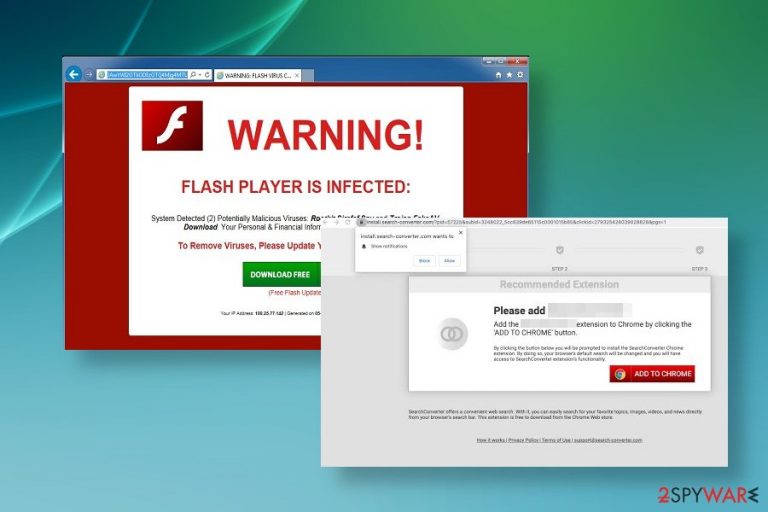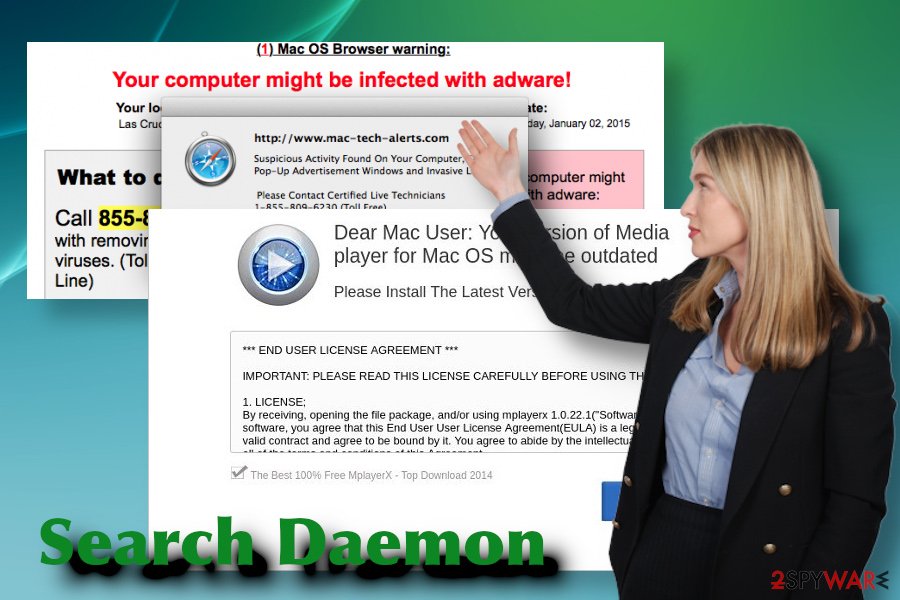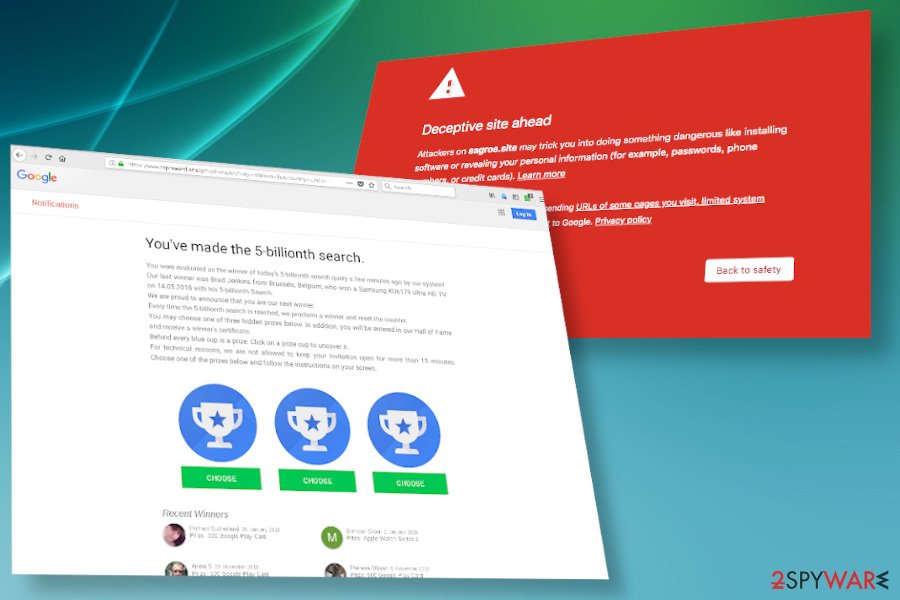Search Daemon (Simple Removal Guide) - Chrome, Firefox, IE, Edge
Search Daemon Removal Guide
What is Search Daemon?
Search Daemon is a browser hijacker targeting Mac users in particular

Search Daemon is the name of a browser-injectable Mac malware[1] that is typically distributed via freeware. The misleading name should not be associated with the virtual drive and optical disc known as Daemon. In fact, some references can be traced since the browser hijacker might be distributed bundled with some of the Daemon versions that are accessible for free on third-party download sources.
The Search Daemon Mac virus – that's the main reference to this tool that can be found on various cybersecurity blogs and forums. Although it's non-malicious, intrusive behavioral traits induce users to call it malicious. Upon installation, which, by the way, happens via freeware bundles and users are not aware of the upcoming browser's hijack, the start page and search engine on Safari, Google Chrome, Mozilla Firefox, and others are replaced by an unknown search, such as search.anysearch.com, search.yahoo.com, searchmine.net, Search.myspeedtestxp.com, and others.
Such a web browser's modifications are usually initiated for marketing purposes, i.e. pay-per-click revenue and traffic boosting. Therefore, the site aims at triggering continuous Search Daemon redirects to the sites of its affiliates. These redirects can be initiated in several ways, i.e. displaying sponsored ads on random sites, injecting scripts onto the browser's settings, which automatically reroutes the traffic once the user types in the search query or URL address. Anyway, these redirects are potentially dangerous due to the uncontrolled third-party content.
| Name | Search Daemon |
| Type | Browser hijacker |
| Sub-Type | Potentially Unwanted Program (PUP) |
| Compatibility | Targeting Mac OS users |
| Distribution | The browser-based malware is typically distributed via freeware downloads |
| Compatible web browsers | It can be injected onto Safari, Google Chrome, Mozilla Firefox, Opera, and other browsers used on Macs. Nevertheless, it can be installed on Internet Explorer, Microsoft Edge, and other Windows browsers as well |
| Symptoms | Altered start page, search engine, new tab URL, and other settings; Unknown extensions installed on the web browser; Intrusive ads generated on random websites; Ongoing redirects via Search Daemon servers. |
| Danger | The extension is not dangerous itself, though it can expose your machine to potentially dangerous third-party sites engaged in malware dissemination or phishing |
| Elimination | Manual and automatic removal options are possible. A free guide is given at the end of the article |
| Fixing malware damage | Browser hijackers are potentially dangerous applications that are capable of initiating some system changes. To fix any unwanted changes, we recommend using FortectIntego repair tool |
Do not download the Search Daemon app for Mac no matter what features it claims to have. Note that it's a heavily ad-supported application that is capable of hijacking web browsers and initiating various advertising campaigns to gain revenue.
Even though it may have a direct download on sources like Mac App Store[2], usually is spread bundled with freeware and shareware as an “optional download” that is supposed to provide additional features (faster web browsing experience, filtered web search results, handy quick access links, etc.). Unfortunately, upon the installation the Search Daemon virus may alter web browser's settings in an unwanted way and initiate pre-default commands without your permission:
- This PUP may change a default start page, search engine, and new tab window;
- Typing search queries into the search bar automatically redirect the browser to suspicious third-party sites;
- Random websites display banner ads with the obviously sponsored content;
- The web browser may load websites asking you to submit personally identifiable information (name, email address, home address, telephone number, etc.) to claim a prize or similar;
- You may notice personalized ads (corresponding to your recent web searches). That's because this application may use tracking cookies to gain information about your browsing preferences and harvest browsing history.

Therefore, even though the application is not harmful, it's important to understand that it is used for affiliate marketing. It means that it's purpose – to promote third-party content and, thus, gain commission for that. For this reason, there's no reason to postpone Search Daemon removal.
Those who have installed the app bundle with freeware, NoVirus.lt[3] experts recommend the automatic Search Daemon removal option. Freeware bundles usually consist of several constituents, so there's a risk that your machine contains more than one unwanted application. You can use any security software that is designed to protect and clean Macs.
Once you remove Search Daemon from Mac, a thorough system scan with FortectIntego is recommended as an additional precautionary measure ensuring that the system is fully optimized. PUPs tend to inject supporting objects into the system's libraries, which may cause slowdowns or crashes over time.
Do not skip steps during the installation of free apps
Software bundling is a legitimate distribution method that is widely used by many app developers. However, this method is not entirely fair, especially when untrustworthy parties are misusing it. Bundling allows developers to disguise setup windows that inform users about the installation of additional apps. The problem is that these apps are pre-selected, so inadequate disclosure leads to the automatic installation of the whole bundle right after clicking the “Finish” button.
Although bundling is useful in its nature as it allows people to use new apps for free, most of the promoted apps are ad-supported and used for their own purposes. Upon installation, these apps tend to hijack web browsers, generate intrusive third-party apps, trigger web-browser redirects, and other unwanted behavior.

Therefore, to prevent this from happening, it's important to select the Advanced or Custom installation technique. Then carefully monitor the installation steps, paying attention to pre-selected and grayed out checkboxes. Deselect all additional applications before clicking the Next button, thus opting out of unwanted apps.
Delete Search Daemon app or other potentially unwanted programs from Mac
The Search Daemon Mac virus is a term used by many people. However, its behavior is more like a potentially unwanted program as it cannot harm the machines itself, except display misleading content. Therefore, experts recommend removing this app to prevent redirect to dangerous websites that may be involved in malware distribution.
For the Search Daemon removal, you can either use a professional anti-malware tool or rely on a manual removal guide that is listed at the end of this article. Make sure to perform all steps in the right order. Unwanted apps may be installed in various locations, so check all possible folders and delete each suspicious application.
However, it might be slightly complicated to remove Search Daemon virus from the Mac system and web browsers as it may install various components within libraries and remain active even after the removal of the main installer. That's why automatic removal using an anti-malware tool is recommended. Besides, a scan with FortectIntego utility might solve future problems due to overfilled registries.
You may remove virus damage with a help of FortectIntego. SpyHunter 5Combo Cleaner and Malwarebytes are recommended to detect potentially unwanted programs and viruses with all their files and registry entries that are related to them.
Getting rid of Search Daemon. Follow these steps
Uninstall from Windows
Instructions for Windows 10/8 machines:
- Enter Control Panel into Windows search box and hit Enter or click on the search result.
- Under Programs, select Uninstall a program.

- From the list, find the entry of the suspicious program.
- Right-click on the application and select Uninstall.
- If User Account Control shows up, click Yes.
- Wait till uninstallation process is complete and click OK.

If you are Windows 7/XP user, proceed with the following instructions:
- Click on Windows Start > Control Panel located on the right pane (if you are Windows XP user, click on Add/Remove Programs).
- In Control Panel, select Programs > Uninstall a program.

- Pick the unwanted application by clicking on it once.
- At the top, click Uninstall/Change.
- In the confirmation prompt, pick Yes.
- Click OK once the removal process is finished.
Delete from macOS
Unwanted Mac apps can be eliminated by running these steps:
Remove items from Applications folder:
- From the menu bar, select Go > Applications.
- In the Applications folder, look for all related entries.
- Click on the app and drag it to Trash (or right-click and pick Move to Trash)

To fully remove an unwanted app, you need to access Application Support, LaunchAgents, and LaunchDaemons folders and delete relevant files:
- Select Go > Go to Folder.
- Enter /Library/Application Support and click Go or press Enter.
- In the Application Support folder, look for any dubious entries and then delete them.
- Now enter /Library/LaunchAgents and /Library/LaunchDaemons folders the same way and terminate all the related .plist files.

Remove from Microsoft Edge
Delete unwanted extensions from MS Edge:
- Select Menu (three horizontal dots at the top-right of the browser window) and pick Extensions.
- From the list, pick the extension and click on the Gear icon.
- Click on Uninstall at the bottom.

Clear cookies and other browser data:
- Click on the Menu (three horizontal dots at the top-right of the browser window) and select Privacy & security.
- Under Clear browsing data, pick Choose what to clear.
- Select everything (apart from passwords, although you might want to include Media licenses as well, if applicable) and click on Clear.

Restore new tab and homepage settings:
- Click the menu icon and choose Settings.
- Then find On startup section.
- Click Disable if you found any suspicious domain.
Reset MS Edge if the above steps did not work:
- Press on Ctrl + Shift + Esc to open Task Manager.
- Click on More details arrow at the bottom of the window.
- Select Details tab.
- Now scroll down and locate every entry with Microsoft Edge name in it. Right-click on each of them and select End Task to stop MS Edge from running.

If this solution failed to help you, you need to use an advanced Edge reset method. Note that you need to backup your data before proceeding.
- Find the following folder on your computer: C:\\Users\\%username%\\AppData\\Local\\Packages\\Microsoft.MicrosoftEdge_8wekyb3d8bbwe.
- Press Ctrl + A on your keyboard to select all folders.
- Right-click on them and pick Delete

- Now right-click on the Start button and pick Windows PowerShell (Admin).
- When the new window opens, copy and paste the following command, and then press Enter:
Get-AppXPackage -AllUsers -Name Microsoft.MicrosoftEdge | Foreach {Add-AppxPackage -DisableDevelopmentMode -Register “$($_.InstallLocation)\\AppXManifest.xml” -Verbose

Instructions for Chromium-based Edge
Delete extensions from MS Edge (Chromium):
- Open Edge and click select Settings > Extensions.
- Delete unwanted extensions by clicking Remove.

Clear cache and site data:
- Click on Menu and go to Settings.
- Select Privacy, search and services.
- Under Clear browsing data, pick Choose what to clear.
- Under Time range, pick All time.
- Select Clear now.

Reset Chromium-based MS Edge:
- Click on Menu and select Settings.
- On the left side, pick Reset settings.
- Select Restore settings to their default values.
- Confirm with Reset.

Remove from Mozilla Firefox (FF)
Remove dangerous extensions:
- Open Mozilla Firefox browser and click on the Menu (three horizontal lines at the top-right of the window).
- Select Add-ons.
- In here, select unwanted plugin and click Remove.

Reset the homepage:
- Click three horizontal lines at the top right corner to open the menu.
- Choose Options.
- Under Home options, enter your preferred site that will open every time you newly open the Mozilla Firefox.
Clear cookies and site data:
- Click Menu and pick Settings.
- Go to Privacy & Security section.
- Scroll down to locate Cookies and Site Data.
- Click on Clear Data…
- Select Cookies and Site Data, as well as Cached Web Content and press Clear.

Reset Mozilla Firefox
If clearing the browser as explained above did not help, reset Mozilla Firefox:
- Open Mozilla Firefox browser and click the Menu.
- Go to Help and then choose Troubleshooting Information.

- Under Give Firefox a tune up section, click on Refresh Firefox…
- Once the pop-up shows up, confirm the action by pressing on Refresh Firefox.

Remove from Google Chrome
In case your web browser continuously displays Search Daemon ads and redirects, follow these steps to reset web browser's settings.
Delete malicious extensions from Google Chrome:
- Open Google Chrome, click on the Menu (three vertical dots at the top-right corner) and select More tools > Extensions.
- In the newly opened window, you will see all the installed extensions. Uninstall all the suspicious plugins that might be related to the unwanted program by clicking Remove.

Clear cache and web data from Chrome:
- Click on Menu and pick Settings.
- Under Privacy and security, select Clear browsing data.
- Select Browsing history, Cookies and other site data, as well as Cached images and files.
- Click Clear data.

Change your homepage:
- Click menu and choose Settings.
- Look for a suspicious site in the On startup section.
- Click on Open a specific or set of pages and click on three dots to find the Remove option.
Reset Google Chrome:
If the previous methods did not help you, reset Google Chrome to eliminate all the unwanted components:
- Click on Menu and select Settings.
- In the Settings, scroll down and click Advanced.
- Scroll down and locate Reset and clean up section.
- Now click Restore settings to their original defaults.
- Confirm with Reset settings.

Delete from Safari
Remove unwanted extensions from Safari:
- Click Safari > Preferences…
- In the new window, pick Extensions.
- Select the unwanted extension and select Uninstall.

Clear cookies and other website data from Safari:
- Click Safari > Clear History…
- From the drop-down menu under Clear, pick all history.
- Confirm with Clear History.

Reset Safari if the above-mentioned steps did not help you:
- Click Safari > Preferences…
- Go to Advanced tab.
- Tick the Show Develop menu in menu bar.
- From the menu bar, click Develop, and then select Empty Caches.

After uninstalling this potentially unwanted program (PUP) and fixing each of your web browsers, we recommend you to scan your PC system with a reputable anti-spyware. This will help you to get rid of Search Daemon registry traces and will also identify related parasites or possible malware infections on your computer. For that you can use our top-rated malware remover: FortectIntego, SpyHunter 5Combo Cleaner or Malwarebytes.
How to prevent from getting browser hijacker
Choose a proper web browser and improve your safety with a VPN tool
Online spying has got momentum in recent years and people are getting more and more interested in how to protect their privacy online. One of the basic means to add a layer of security – choose the most private and secure web browser. Although web browsers can't grant full privacy protection and security, some of them are much better at sandboxing, HTTPS upgrading, active content blocking, tracking blocking, phishing protection, and similar privacy-oriented features. However, if you want true anonymity, we suggest you employ a powerful Private Internet Access VPN – it can encrypt all the traffic that comes and goes out of your computer, preventing tracking completely.
Lost your files? Use data recovery software
While some files located on any computer are replaceable or useless, others can be extremely valuable. Family photos, work documents, school projects – these are types of files that we don't want to lose. Unfortunately, there are many ways how unexpected data loss can occur: power cuts, Blue Screen of Death errors, hardware failures, crypto-malware attack, or even accidental deletion.
To ensure that all the files remain intact, you should prepare regular data backups. You can choose cloud-based or physical copies you could restore from later in case of a disaster. If your backups were lost as well or you never bothered to prepare any, Data Recovery Pro can be your only hope to retrieve your invaluable files.
- ^ Sara Morrison. Apple’s malware problem is getting worse. Vox. American news and opinion website.
- ^ Brian Barrett. How 18 Malware Apps Snuck Into Apple's App Store. Wired. American news and opinion website.
- ^ SECURITY AND SPYWARE NEWS. NoVirus. Virus and spyware news.
